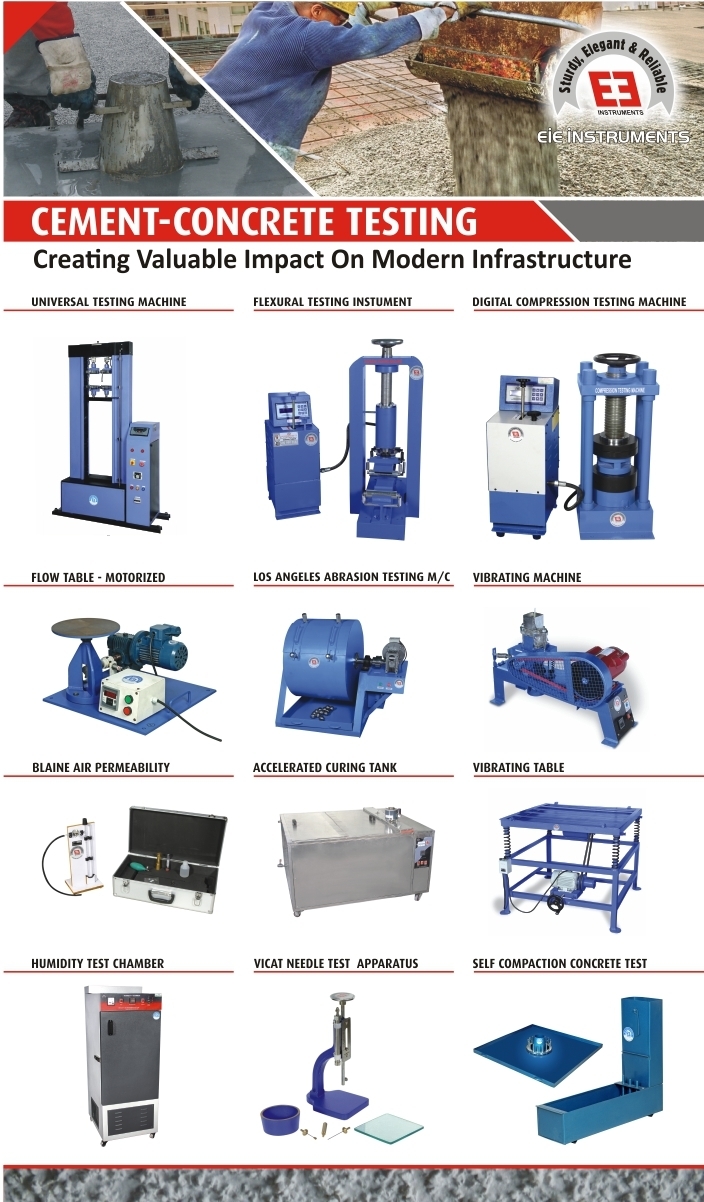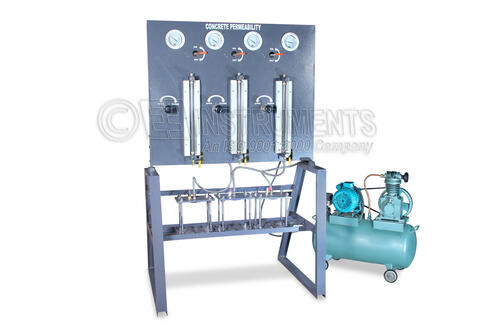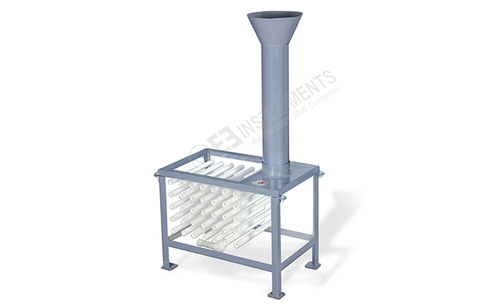J Ring Test Apparatus
Price 1.00 INR/ Piece
J Ring Test Apparatus Specification
- Dimension (L*W*H)
- 1000 X 1070 X 300(L X W X D) mm Millimeter (mm)
- Response Time
- Instant
- Measuring Range
- Height difference measurement (mm)
- Accuracy
- 1 mm
- Max Height
- 100 mm (Height measured from concrete flow)
- Operating Voltage
- 230 V
- Mounting Type
- Free standing
- Power Supply
- 230 V AC
- Test Range
- Suitable for SCC passing ability assessment
- Humidity
- Ambient
- Usage
- For Concrete Testing
- Features
- Stainless steel construction, easy to assemble, rust resistant
- Frequency
- 50 Hz
- Hardness
- High strength steel bars
- Specimen Size
- Standard Cylinder for SCC (Concrete)
- Display Type
- Manual Visual
- Automation Grade
- Manual
- Product Type
- J Ring Test Apparatus
- Resolution
- 1 mm
- Number of Specimens
- 1 at a time
- Application
- The Jring test can be used to determine the passing ability of selfconsolidating concrete
- Temperature
- Ambient
- Interface Type
- Manual
- Capacity
- Standard apparatus for up to 7-12 mm rebars
- Machine Weight
- Approx. 18 kg
- Test Speed
- Manual Operation
- Test Width
- 300 mm (Diameter of test area)
- Control Mode
- Manual
J Ring Test Apparatus Trade Information
- Minimum Order Quantity
- 1 Piece
- FOB Port
- Ahmedabad
- Supply Ability
- 100 Pieces Per Month
- Delivery Time
- 8 Week
- Sample Policy
- Contact us for information regarding our sample policy
- Packaging Details
- Wooden Box / Corrugated Box
- Main Export Market(s)
- Australia, South America, Middle East, Africa, Asia
- Main Domestic Market
- All India
- Certifications
- ISO 9001 : 2015
About J Ring Test Apparatus
Application:
The J ring test can be used to determine the passing ability of self consolidating concrete. It is applicable for laboratory use in testing different concrete mixtures for passing ability or can be used in the field as a quality control test. Passing ability refers to the ability of SCC, under its own weight to flow into and completely fill the spaces within an intricate framework, containing obstacles such as reinforcement bars
Details:
The equipment consists of rectangular section of38 mm X 25 mm open steel ring drilled vertically with holes to accept threaded section of reinforcing bars. The bars and sections can be placed at different distance apart to simulate the congestion of reinforcement of the ring formed by vertical section.
Further details availableon our website.
The Price mentioned here are subject to change as per the capacity,specifications and application of the user.
Precision Engineering for Concrete Testing
The J Ring Test Apparatus is meticulously engineered from high-quality stainless steel and toughened steel rods, delivering reliable assessments of SCC passing ability. Its robust and rust-resistant build ensures consistent performance in demanding environments, while the polished finish makes handling and cleaning hassle-free.
Compliant with International Standards
Designed to meet ASTM C1621 / C1621M requirements, the apparatus upholds rigorous quality and testing criteria. This adherence provides confidence in the validity of each test, making the equipment suitable for professional and standardized applications in various construction settings.
Manually Operated for Maximum Control
Offering full manual control, the J Ring Test Apparatus allows users to manage test speed and process with ease. The design ensures precise measurement of the concretes flow height, with instant visual feedback and a measuring resolution of 1 mm, ensuring dependable and repeatable outcomes.
FAQs of J Ring Test Apparatus:
Q: How is the J Ring Test Apparatus used in concrete testing?
A: The J Ring Test Apparatus is used to evaluate the passing ability of self-consolidating concrete (SCC) as it flows through an array of steel rods, simulating reinforcement in structural elements. It helps determine how well SCC can move through spaces within a formwork, ensuring suitability for projects requiring high flowability.Q: What are the main benefits of using this apparatus for SCC assessment?
A: The main benefits include precise measurement of flow height (accuracy up to 1 mm), robust rust-resistant construction, and full compliance with ASTM standards. These features enable accurate, repeatable evaluations of SCCs performance, supporting quality control in both research and practical construction environments.Q: When should I use the J Ring Test during concrete work?
A: The J Ring Test is typically performed during the fresh concrete stage, immediately after mixing and before placement. This timing ensures an accurate assessment of SCCs passing ability and workability before the mix is poured into its final structural form.Q: Where is the J Ring Test Apparatus most commonly used?
A: This apparatus is used in laboratories, quality control stations, construction sites, and research facilities to test SCC mixes. Its portability and free-standing design make it suitable for a range of operational environments.Q: What process does the J Ring Test follow?
A: The process involves filling a standard cylinder with SCC inside the ring of vertical steel rods, removing the mold, and measuring the resulting flow spread and height difference at multiple points around the ring. This procedure helps evaluate the mixs ability to pass through simulated reinforcement without segregation.Q: What makes the construction of this apparatus advantageous?
A: Its stainless steel and high-strength steel rod construction provides corrosion resistance, high durability, and long service life. The polished finish allows for easy cleaning, and the modular design ensures straightforward assembly and disassembly.Q: How does the manual operation influence test results?
A: Manual operation gives users direct control over each step of the process, reducing the potential for operational error and enhancing the repeatability of tests. Instant visual display of results makes the assessment clear and user-friendly.


Price:
- 50
- 100
- 200
- 250
- 500
- 1000+
More Products in Concrete Testing Equipment Category
Concrete Permeability Tester
Price 1.00 INR / Piece
Minimum Order Quantity : 1 Piece
Application : Water Permeability testing machine with 3 cells to determine the depth of penetration of the water into the concrete (impermeability) under known time and pressure.
Machine Weight : Approx. 55 kg
Usage : Concrete Testing Equipment
Interface Type : Manual controls, optional digital interface
Fill Box Apparatus
Price 1.00 INR / Piece
Minimum Order Quantity : 1 Piece
Application : The test is used to measure the filling ability of self compacting concrete with a maximum aggregate size of 20 mm.Â
Machine Weight : Approx. 15 kg
Usage : Concrete Testing
Interface Type : Manual
Concrete Penetrometer - Spring Type
Price 1.00 INR / Piece
Minimum Order Quantity : 1 Piece
Application : This test is used to determine the elapsed time between batching of a concrete sample and when it is deemed by standard methods to have set
Machine Weight : Approx. 1.5 kg
Usage : Penetration Resistance
Interface Type : Mechanical Push Rod
Splitting Tensile Testing Machine for Concrete
Price 1.00 INR / Piece
Minimum Order Quantity : 1 Piece
Application : Concrete cylinder splitting / indirect tensile test
Machine Weight : Approx. 350 kg
Usage : Concrete specimen tensile strength test
Interface Type : Push button / Manual valve
 |
EIE INSTRUMENTS PVT. LTD.
All Rights Reserved.(Terms of Use) Developed and Managed by Infocom Network Private Limited. |

 Send Inquiry
Send Inquiry




